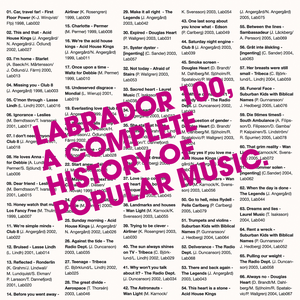His debut release was the 5-track EP, Go to Hell, Miss Rydell followed later in the year by the full-length Everything. Now!. Two years later, the upbeat In a Nutshell followed. It wasn't long before the third effort The Lilac Time was released in Summer 2008.
Pelle now make music with his own children in a project called Tvillingarna, Truls & Jag.
Riverbank
Pelle Carlberg Lyrics
Jump to: Overall Meaning ↴ Line by Line Meaning ↴
And I'm lucid while it shimmers
But the undertow is stronger than I thought
I throw my money in the river
And I'm happy while it shimmers
Then I regret the stupid things that I have bought
Doodoo...
In the temple of consumption
Every store wants my transactions
There's a tightrope that I walk without a doubt
In the temple of consumption
My dole money has a function
Until I realize my balance is whipped out
Doodoo...
Tailor made shirts and French tile
Cotton rich socks in argyle
Face creams, lotions and potions
I'm still me
Doodoo...
No dough!
The song "Riverbank" by Pelle Carlberg is a commentary on consumerism and the various materialistic cravings that come with it. In the initial verse, Carlberg throws his money in the river and becomes "lucid" while observing it shimmer. However, he soon realizes that he's not immune to the undertow as he thought and begins to regret the frivolous things he's spent his money on. He's trying to express his conflicted feelings about commerce and how it's easy to get swept up in the shiny allure of material possessions, yet it's hard to ignore the sense of dissatisfaction that arises later.
The second verse brings up the concept of the "temple of consumption," a metaphor for consumerism. Each store is vying for attention and transactions, and it's all too easy to get roped into a cycle of purchasing without considering the consequences. Carlberg mentions walking a tightrope, hinting at how precarious the situation is when you become dependent on buying things. Even though there's the illusion of control over the situation, one's balance can get wiped out if they're not careful. This verse encapsulates the experience of being a consumer, someone who's constantly surrounded by ads and options but ultimately feels unsatisfied.
The chorus features a series of materialistic items like tailor-made shirts, French tiles, and face creams. Despite all these things, Carlberg emphasizes that he's still himself, suggesting that ultimately these possessions don't define who he is. The song ends with Carlberg exclaiming "No Dough!" which could be interpreted as him not having enough money to continue engaging in the cycle of consumption, or as a refusal to participate in that system altogether. The lyrics of "Riverbank" suggest a disconnect between people's desires for material goods and their true sense of self and well-being.
Line by Line Meaning
I throw my money in the river
The singer throws his money into the river to eliminate his attachment to material things.
And I'm lucid while it shimmers
He revels in the beauty of the way the money shines in the water.
But the undertow is stronger than I thought
The singer finds it hard to resist the temptation of materialism.
Then I regret the stupid things that I have bought
Once he comes to his senses, he regrets the things he bought with his money.
In the temple of consumption
The shopping mall represents an environment of consumerism.
Every store wants my transactions
Every store is in the business of selling goods, and they are bidding for his money.
There's a tightrope that I walk without a doubt
He recognizes that he is walking on a tightrope between maintaining a healthy balance of spending and being consumed by consumerism.
My dole money has a function
He uses his welfare support to fuel his shopping addiction.
Until I realize my balance is whipped out
Once he has spent his money, he becomes aware of his inability to afford basic necessities.
Tailor made shirts and French tile
He lists off various expensive items that he buys.
Cotton rich socks in argyle
Another example of the upscale commodities he purchases.
Face creams, lotions and potions
Additional examples of his high-end consumer choices.
I'm still me
Despite his lavish spending habits, the singer has not changed as a person.
No dough!
He has no money left.
Contributed by Lucas Y. Suggest a correction in the comments below.
